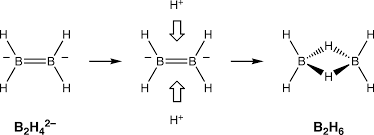
$$\mathrm{BCl}_{3}$$ does not exist as dimer but $$\mathrm{BH}_{3}$$ exists as dimer because
(A)Chlorine is more electronegative than hydrogen
(B)There is pπ– pπ back bonding in $$\mathrm{BCl}_{3}$$ but $$\mathrm{BH}_{3}$$ does not contain such multiple bonding
(C)Large sized chlorine atoms do not fit in between the small boron atoms whereas small-sized hydrogen atoms get fitted in between boron atoms
(D)None of the above
Answer
219.9k+ views
Hint: The dimerisation is due to the unstable structure of $$\mathrm{BH}_{3}$$. There is a share of electrons in between the molecules.
Complete step by step solution:
Chlorine is a group 17 element whereas, Boron is a group 13 element Thus the size of boron is much much less than the size of the chlorine.
So if we try to make B2Cl6 it is not possible for this compound to be stable but diborane(B2H6) can form since hydrogen is a very very smaller atom than chlorine. If there is the bonding between two atoms where one atom is having one vacant orbital and another is having one lone pair of electrons, then if this electron pair is donated to that respective vacant orbital then the bonding is called pπ– pπ or pπ– dπ depending on the orbital to which the electron pair is donated and from which the electron pair is donated.
The bonding between the boron atoms and the bridging hydrogen atoms is, however, different from that in molecules such as hydrocarbons. Each boron uses two electrons in bonding to the terminal hydrogen atoms and has one valence electron remaining for additional bonding. The bridging hydrogen atoms provide one electron with each. The B2H2 ring is held together by four electrons which form two 3-centre 2-electron bonds. This type of bond is sometimes called a 'banana bond'.

The answer is option (C).
Note:/b<> There is no relation of electronegativity or back bonding for dimerisation of $$\mathrm{BH}_{3}$$. It only depends on the size of the other molecule that bonds with it.
Complete step by step solution:
Chlorine is a group 17 element whereas, Boron is a group 13 element Thus the size of boron is much much less than the size of the chlorine.
So if we try to make B2Cl6 it is not possible for this compound to be stable but diborane(B2H6) can form since hydrogen is a very very smaller atom than chlorine. If there is the bonding between two atoms where one atom is having one vacant orbital and another is having one lone pair of electrons, then if this electron pair is donated to that respective vacant orbital then the bonding is called pπ– pπ or pπ– dπ depending on the orbital to which the electron pair is donated and from which the electron pair is donated.
The bonding between the boron atoms and the bridging hydrogen atoms is, however, different from that in molecules such as hydrocarbons. Each boron uses two electrons in bonding to the terminal hydrogen atoms and has one valence electron remaining for additional bonding. The bridging hydrogen atoms provide one electron with each. The B2H2 ring is held together by four electrons which form two 3-centre 2-electron bonds. This type of bond is sometimes called a 'banana bond'.

The answer is option (C).
Note:/b<> There is no relation of electronegativity or back bonding for dimerisation of $$\mathrm{BH}_{3}$$. It only depends on the size of the other molecule that bonds with it.
Recently Updated Pages
Electricity and Magnetism Explained: Key Concepts & Applications

JEE Energetics Important Concepts and Tips for Exam Preparation

JEE Isolation, Preparation and Properties of Non-metals Important Concepts and Tips for Exam Preparation

JEE Main 2021 July 25 Shift 1 Question Paper with Answer Key

JEE Main 2021 July 22 Shift 2 Question Paper with Answer Key

States of Matter Chapter For JEE Main Chemistry

Trending doubts
JEE Main 2026: Application Form Open, Exam Dates, Syllabus, Eligibility & Question Papers

Derivation of Equation of Trajectory Explained for Students

Hybridisation in Chemistry – Concept, Types & Applications

Understanding the Angle of Deviation in a Prism

Understanding Atomic Structure for Beginners

How to Convert a Galvanometer into an Ammeter or Voltmeter

Other Pages
NCERT Solutions For Class 11 Chemistry Chapter 7 Redox Reaction

JEE Advanced Marks vs Ranks 2025: Understanding Category-wise Qualifying Marks and Previous Year Cut-offs

Thermodynamics Class 11 Chemistry Chapter 5 CBSE Notes - 2025-26

NCERT Solutions ForClass 11 Chemistry Chapter Chapter 5 Thermodynamics

Hydrocarbons Class 11 Chemistry Chapter 9 CBSE Notes - 2025-26

Equilibrium Class 11 Chemistry Chapter 6 CBSE Notes - 2025-26




